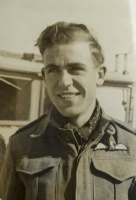In later years he modestly commented; “Whilst with 6 Squadron, a number of small ships, and a few bigger ones, got in the way of my rockets, which happened to be carrying 60lb high explosive heads. In appreciation of this, I was issued with a piece of blue and white ribbon!”
The son of a bricklayer, John Frederick Nicoll was born in Walthamstow on November 5 1920 and educated at the local Sir George Monoux Grammar School. He enlisted in the RAF in November 1940 and six months later started his flying training.
He sailed for South Africa before travelling to Salisbury in Southern Rhodesia (now Zimbabwe) where he spent the next eight months completing his training as a pilot. He was commissioned and left for Egypt and on to Syria to train on Hurricanes in the tactical reconnaissance role. In September 1942 he joined 208 Squadron at Burgh-el-Arab, 40 miles behind the front line in the Western Desert.
The Eighth Army was established at El Alamein and the squadron  flew reconnaissance sorties to identify enemy positions and ground movements. Nicoll flew his first sortie on October 3 when he acted as the “weaver” (escort) to a colleague who concentrated on taking photographs and making visual observations. Over the next few days, Nicoll flew further sorties when large concentrations of enemy vehicles and tanks were noted. On the 12th, on a sortie to the edge of the Qattara Depression, he reported over 600 motor transports dispersed and heavy movements of road traffic in the region. On later sorties he photographed the enemy’s forward defence positions.
flew reconnaissance sorties to identify enemy positions and ground movements. Nicoll flew his first sortie on October 3 when he acted as the “weaver” (escort) to a colleague who concentrated on taking photographs and making visual observations. Over the next few days, Nicoll flew further sorties when large concentrations of enemy vehicles and tanks were noted. On the 12th, on a sortie to the edge of the Qattara Depression, he reported over 600 motor transports dispersed and heavy movements of road traffic in the region. On later sorties he photographed the enemy’s forward defence positions.
When the Battle of Alamein commenced, Nicoll’s flight had been withdrawn to the Canal Zone, with the squadron’s other two flights seeing most of the action
At the beginning of 1943 the squadron moved to Kirkuk in Iraq for intensive training and to provide support for the Army’s 21 Corps and the Polish Brigade Group. After six months, it moved to Rayak in Syria and in October, Nicoll was posted to 6 Squadron.
On his return to England after a three-and-half-year absence, Nicoll joined a ferry flight delivering aircraft throughout the United Kingdom. His final posting was to 631 Squadron based in West Wales and equipped with the Griffon-engined Spitfire and the Vengeance towing target drogues for visiting squadrons to practice air-to-firing. He was finally demobilized in May 1946.
Taking advantage of a government training scheme, Nicoll attended Brixton School of Building and became a quantity surveyor before working in Wrexham and Stevenage where he later established his own company.









